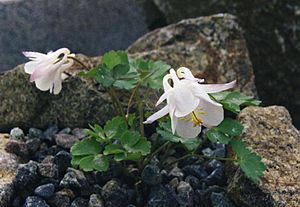Laramie columbine facts for kids
Quick facts for kids Laramie columbine |
|
|---|---|
 |
|
| Conservation status | |
| Scientific classification | |
| Genus: |
Aquilegia
|
| Species: |
laramiensis
|
The Laramie columbine (Aquilegia laramiensis) is a special kind of flowering plant. It belongs to the buttercup family. This plant is found only in one place: the Laramie Mountains in Wyoming, United States. This makes it an endemic species, meaning it lives naturally in just one specific area.
About the Laramie Columbine
What It Looks Like
This plant is a perennial herb. This means it lives for more than two years. It has soft, green stems instead of woody ones. It grows from underground stems called rhizomes. Its stems can reach up to 25 centimeters (about 10 inches) long.
The leaves are made up of several smaller leaflets. The flowers hang downwards. They can be greenish-white or light purple. Each flower has sepals up to 1.5 centimeters long. The petals are cream-colored to light purple. They are about 1.2 centimeters long. They have thick, hooked parts called spurs. After the flower, a fruit called a follicle grows. It can be up to 1.4 centimeters long.
Where It Grows
The Laramie columbine grows only in the Laramie Mountains. This mountain range is in Albany and Converse Counties in Wyoming. Many of these plants live inside Medicine Bow National Forest. Others are on land managed by the Bureau of Land Management. Some are also found on private land.
The groups of plants are usually small. Most have fewer than 100 individual plants.
Its Home and Neighbors
This plant likes to grow on large rock outcrops. It finds small pockets of soil and cracks in the rocks. These rocky areas are often surrounded by forest habitat. Sometimes, they are near sagebrush or grassland areas.
The Laramie columbine prefers shady spots. It grows alongside other plants. Some of its plant neighbors include:
- Fragile fern (Cystopteris fragilis)
- Little-flowered alumroot (Heuchera parvifolia)
- Glandular oceanspray (Holodiscus dumosus)
- Mountain ninebark (Physocarpus monogynus)
- Brandegee's Jacob's ladder (Polemonium brandegeei)
- Bigflower cinquefoil (Potentilla fissa)
- Red raspberry (Rubus idaeus)
- Idaho ragwort (Senecio rapifolius)
- Rocky Mountain woodsia (Woodsia scopulina)
Because it lives in remote and rugged places, there are no big threats to this plant right now.


